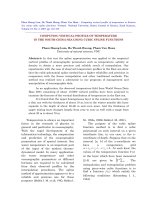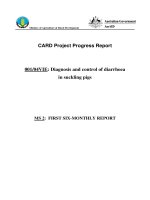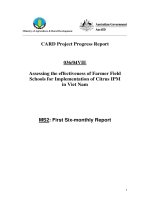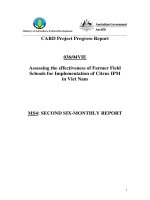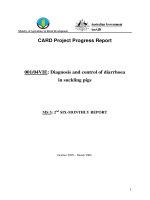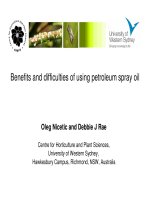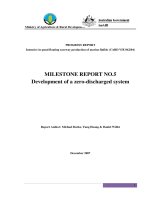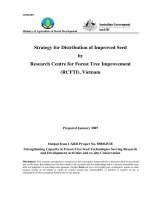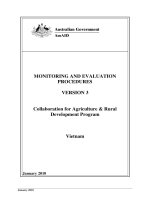Báo cáo nghiên cứu khoa học " Benefits and difficulties of using petroleum spray oil " pot
Bạn đang xem bản rút gọn của tài liệu. Xem và tải ngay bản đầy đủ của tài liệu tại đây (11.64 MB, 70 trang )
Benefits and difficulties of using petroleum spray oil
Oleg Nicetic and Debbie J Rae
Centre for Horticulture and Plant Sciences,
University of Western Sydney,
Hawkesbury Campus, Richmond, NSW, Australia
Presentation Overview
• Spray oil defined
• Emulsifiers
• How spray oil works
• PSO vs conventional pesticide
• Phytotoxicity limiting factor for spray oil use
• Spray oil as pest control agent on its own
• Spray oil as an adjuvant
• Use of spray oil for spray drift reduction
Spray oil defined
Spray oil nomenclature
• White oil
• Petroleum Spray Oil (PSO)
• Mineral Spray Oil (MSO)
• Agricultural Mineral Oil (AMO)
• Horticultural Mineral Oil (HMO)
• Narrow range vs broad range
• Winter oil vs Summer Oil
• PSOs are derived from lubricating oils.
Three main types of molecules make up a
spray oil:
– Isoparaffins: provide most of the efficacy.
– Naphthenes: less effective than isoparaffin.
– Aromatics: a cause of plant damage.
Median n-
paraffin
carbon number
Viscosity 50% distillation temperature
ASTM D 2887 Saybolt universal
seconds (SUS) at 37.8ºC
ASTM D 445
1.33 kPa (10 mm
Hg) ASTM D 1160
101.33 kPa (760 mm
Hg) ASTM D 447
°
C
°
F
°
C
°
F
nC19 331
628
nC20
344
651
nC21 ‘60’ 212 415 356
673
nC23
‘70’
224 435 380
716
nC24
‘80’
235
455 391
736
nC25 ‘100’ 247 476 401
754
nC27 421
790
• Oils can be light or heavy as measured by nCy
(carbon number)
– Generally range from nC21 (light) – nC25 (heavy)
– Carbon number is related to the temperature
20
196
344
10%
Values
24.3
243.5
394.5
50% 90%
27.4D 2887Equivalent n-paraffin carbon number (nCy)
265.5D 1160at 1.33 kPa
426D 2887
Distillation temperatures (C) at 101.33 kPa
ASTM Method
Key properties of SK base oil
Other Values
C
P
74, C
N
26, C
A
0D 2140Molecular types (%)
0.8299D 1298Density at 15 °C
99.8
D 483Unsulfonated residue (% UR: minimum)
- 24D 97Pour point (°C: maximum)
12.43
3.12
D 445Viscosity: Kinematic at 40°C
at 100°C
71.1D 2161Viscosity: Saybolt at 37.8°C
340D 2502Mean molecular weight
Emulsifier
OIL
EMULSIFIER
WATER
Oil + Emulsifier = Spray oil
OIL
WATER
Typically PSOs contain from 0.35 to 2%
emulsifiers. However as PSO paraffinicity and
unsulfonated residue (= hydrogen saturation)
increase, it becomes more difficult to form oil-water
emulsion thus the content of emulsifiers can
increase to 6%.
Modern oils form quick breaking emulsions that
ideally should break on contact with the target-the
oil thinly coating the target, the water running off.
Water
Oil
Water runs off
Oil remains
on leaf surface or
moves into leaf
Quick-break oil in
water emulsions
Practical implication for using oils in field
Proper and constant agitation of the water-oil emulsion in
the tank. Temperature of the mixture in the tank or in the
hose should never exceed 420 C.
Adding oil to the adequate (sufficient) quantity of water
and providing agitation while mixing.
Be careful when making tank mix of oil and other
pesticide specially when WP are added. Tank should be
nearly full with oil emulsion and then pre-mixed WP
should be added. As general rule it should not be more
than 0.1kg of insoluble powder per 100 L of oil-water
emulsion.
Stability of emulsion
Depending on quantity and type of emulsifier, emulsion
of PSO and water can be stable from few minutes to few
hours. Generally current PSOs have emulsion stability
from 20 minutes to 2 hours.
In the tank, emulsion should never been left without
agitation for more than 20 minutes
After emulsion was sprayed to the plant deposit should
dry within 2 hours, preferably within 30 minutes.
PSO vs. conventional pesticide
Advantages over conventional pesticide
• They have very low toxicity to vertebrate
animals and humans
• They may be handled with minimum
protective clothing
• They are less harmful to beneficial insects
and mites
• Pests cannot develop resistance
Disadvantages over conventional
pesticide
• Higher risk to cause phytotoxicity that limits
PSO’s use when plants are stressed and when
temperature and relative humidity is high.
• To be effective PSO has to be sprayed at higher
volume then most conventional pesticides which
increases labour costs, increases time of
spraying and requires availability of lot of water.
• Overall in the short term PSO based IPM
program is more expensive than conventional
program but in the longer term they could have
economic benefits.
Phytotoxicity
Phytotoxicity is major limitation for use of
oil as an insecticide, a deterrent or as an
adjuvant.
Why PSO is phytotoxic
Every mineral oil interferes with plant physiological
functions including transpiration and movement of
phytohormones.
In the last 10 years progressively higher mean carbon
number oils are being used and these oils more strongly
affect plant physiological functions.
Recommendations for spraying oil need to be more
cautious and should never exceed recommended label
dose and cumulative yearly dose.
Recommended label dose and cumulative yearly dose
vary from species to species but usually tangerines and
mandarins are most susceptible, pomelos and navel
oranges are intermediate, sweet oranges, lemons and
grapefruit are less susceptible.
Major causes of phytotoxicity
–Presence of aromatics and impurities in oil
–Amount of oil deposited on plant
–High temperatures (particularly over 35°C)
–Presence of moisture or heat stress
–Plant type and growth stage
–Poor agitation
–Incompatible mixing
Acute phytotoxicity
Oil soaking
Oil soaking precursor to phytotoxicity
A particularly high risk for the use of oil is temperatures over
30
0
and relative humidity over 80%; conditions that are often
present in the tropics.
Oil viscosity decreases with increased temperature and it
takes a long time for oil to dry so penetration into plant is
very high and soaking can be observed after a single low
concentration spray.
When oil soaking is detected, oil sprays should be
discontinued until oily spots disappear. Unfortunately under
humid tropical conditions it takes a long time for oily spots to
diffuse from the fruits.
Leaf drop
20 sprays at 0.2% PSO12 sprays at 0.4% PSO
